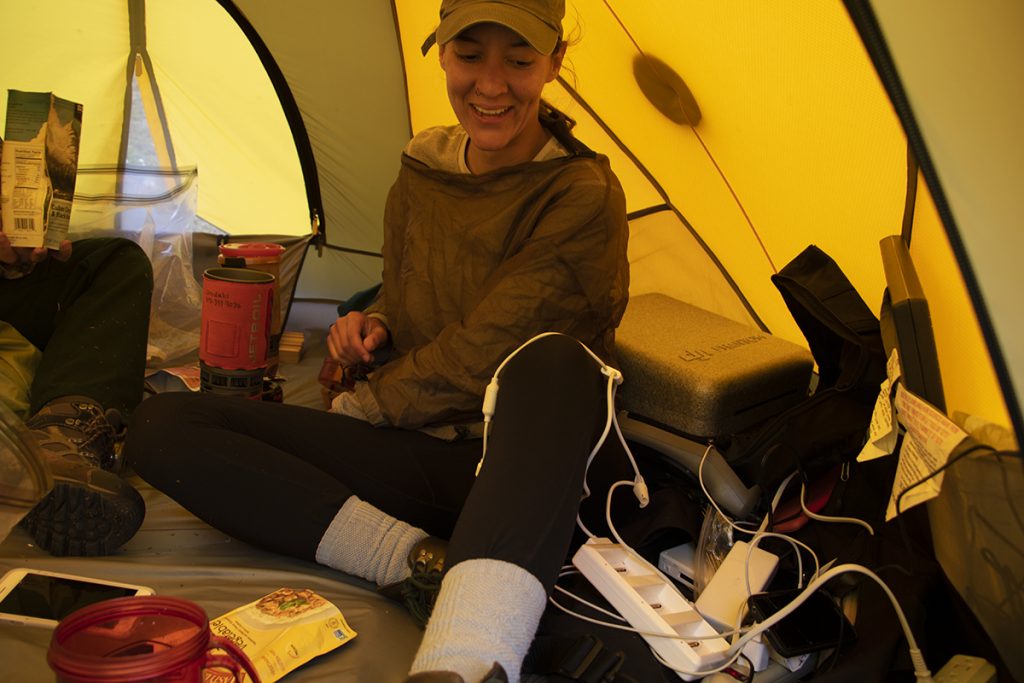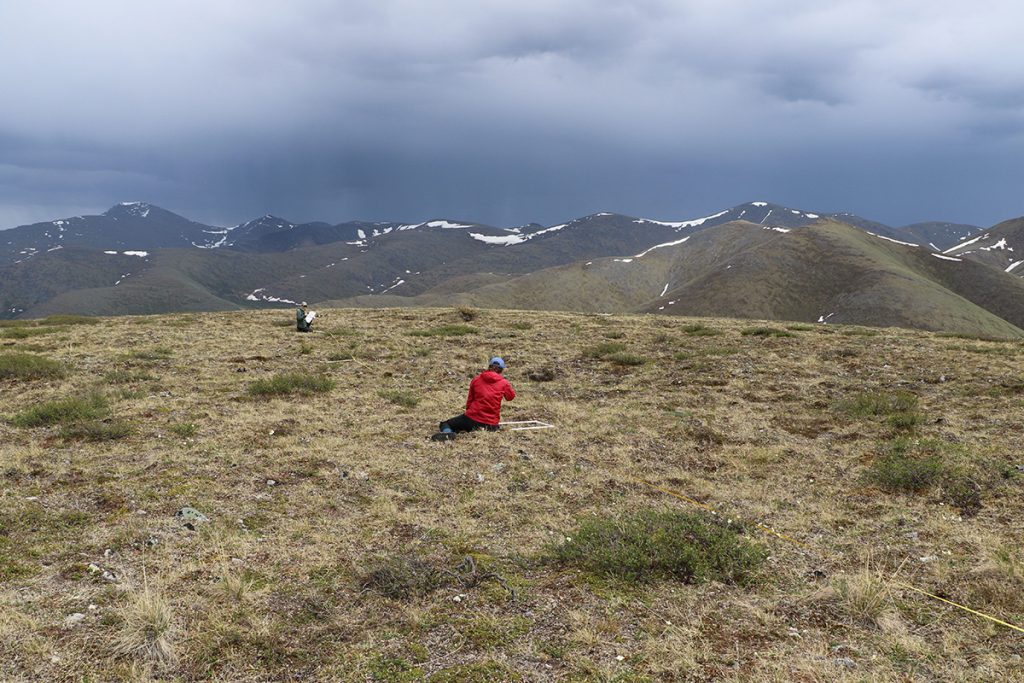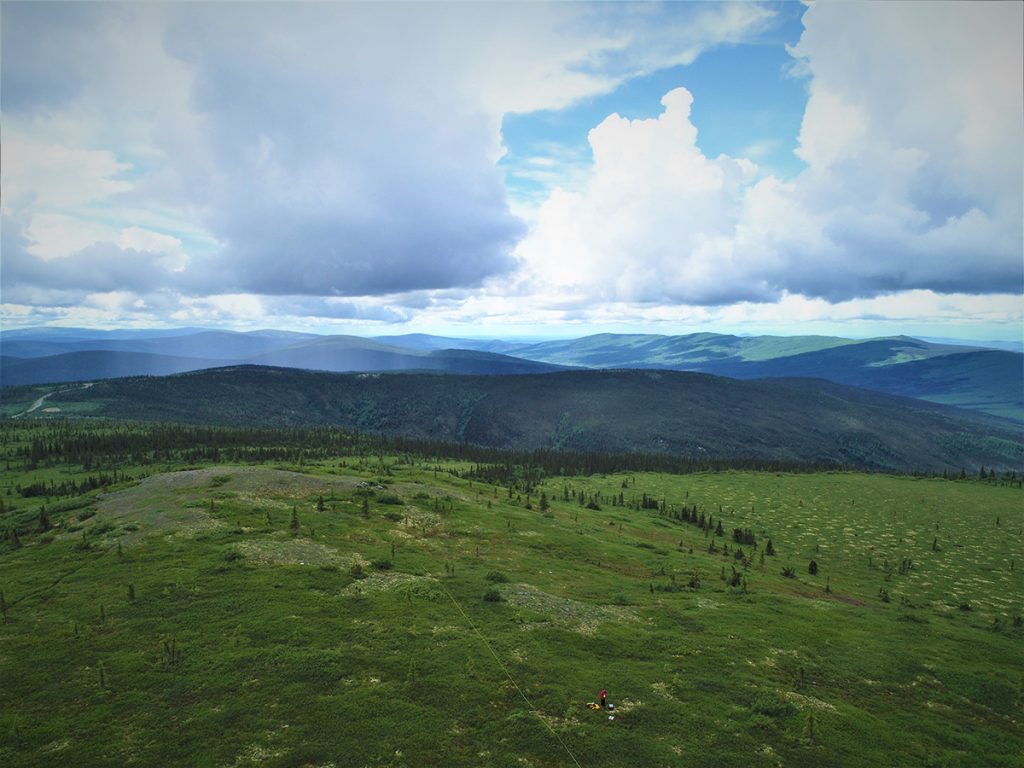June 11, 2019
Alaska is home to more caribou than it is to humans. It stands to reason, then, that these large mammals will have a significant impact on their Arctic homeland.
That impact has yet to be fully quantified, in large part because the environments where caribou live are hard to access and plan around. Northern Arizona University doctoral student Katie Orndahl faced these challenges often during her three years doing research in Fairbanks, Alaska, frequently taking bush planes into the wilderness to get a few pieces of on-the-ground data. Wondering if there was a better way to collect data, she looked for ways to be in the field without actually being in the field.
That question led her to NAU’s School of Informatics, Computing, and Cyber Systems in 2017, and her work in the last two years using remote sensing to gather data led her to admittance into the National Science Foundation’s Graduate Research Fellowship Program—one of the most prestigious recognitions for STEM graduate students. The fellowship also comes with a financial benefit; Orndahl will receive an annual stipend along with funding to conduct original research.
“It is a privilege to be in this company,” Orndahl said. “Graduate research fellows are an inspiring group of people, and I never thought I’d get to count myself one of them. A fellowship like this has the potential to open a lot of doors. It comes with a lot of freedom to pursue research directions that I’m passionate about, plan field campaigns that otherwise might not be possible and get creative with my work.”
Answering tough questions
Prior to NAU, Orndahl spent a year with the Bureau of Land Management and two and a half years with the Arctic National Wildlife Refuge (ANWR), both in Fairbanks. Working in ANWR was a valuable experience; not only did Orndahl have a breathtaking, vast wilderness for an “office,” but she got hands-on experience studying Arctic vegetation ecology and botany. She saw the necessity of the work she was doing in understanding and preserving the natural resources in the area.

Above: Operating the drone as captured by the drone. Photo credit: Katie Orndahl
She also confronted the challenges. ANWR doesn’t have roads; all transportation is done by bush plane. To not waste money or resources like fuel, which impacted the ecosystem they’re trying to protect, her team had to make meticulous plans, which ate up time and still required significant resources to complete. And even with the best of planning, nature is unpredictable. They often returned from a trip with only a few data points.
However, fieldwork remained critical to what they were doing. The detailed data they picked up was necessary for gaining a thorough understanding of the landscapes they studied. Orndahl began looking at ways to get in the field remotely.
“I became increasingly interested in remote sensing—what information we can extract from images, how this information can stretch field data across regions and what discoveries can be made as a result,” she said. “It was this interest that spurred me to return to school and further my education.”
Her mentors at the refuge were longtime colleagues of Scott Goetz, a professor in the School of Informatics, Computing, and Cyber Systems. They connected Orndahl and Goetz electronically, and in a one-day window between rafting through the Grand Canyon and returning to her work in Fairbanks, she came to Flagstaff to meet Goetz and tour NAU. She was excited about the research and, after the sunless winters of Alaska, really into the cold but sunny Flagstaff days.
Goetz watched as his new graduate student immersed herself in processing large satellite datasets and considered how to help answer a research question other collaborators put forward: what factors influence how caribou move across vast landscapes? To answer that question, researchers needed maps of how tundra vegetation composition relates to how caribou move through their habitat, including their foraging preference.
In her research, Orndahl uses remote sensing techniques to study the interactions between caribou and vegetation. Caribou are one of only two large herbivores that live fully in the Arctic and are one of the region’s most ecologically, culturally and economically important species. About 750,000 live in Alaska (part of about 5 million caribou in the world), and scientists know they have a significant impact on the vegetation, both through grazing and trampling. Any impact on vegetation will affect how much forage is available to caribou and impact carbon storage, which is increasingly becoming an issue in Arctic and subarctic environments. They have yet to quantify just how much of an effect the caribou have, however, as animal impacts are typically not included in carbon cycle models.
Recent research has suggested that including the impacts of animals like caribou may help fill in gaps in scientists’ understanding of carbon cycling and accounting.
Her research will quantify how different herd densities affect vegetation cover and structure; using machine learning techniques and remote sensing tools like drones, airborne lidar, hyperspectral and satellite imagery, she will estimate the per plant functional type above-ground vegetation biomass. This data, along with caribou GPS collar data, should allow her to build a model that shows the relationship between caribou and vegetation, which then can inform wildlife management decisions, improve the modeling of vegetation change over time and get researchers closer to understanding how animals impact carbon cycling.
This research has taken her back to Alaska, though in the more pleasant months; last summer she went to 34 sites within the Fortymile caribou herd range in the state, and she leaves for the Yukon Territories later in June to visit sites within the Porcupine caribou herd range.
The NSF fellowship
The GRFP application process is taxing; there are research proposals, personal essays, questions about five- and 10-year research plans, and most of these were limited to two pages. For as much work as it was, though, Orndahl found the opportunity itself valuable. Writing her personal statement allowed her to learn more about herself and the reasons she pursues science, while writing a proposal for a years-long, data-intensive project in two pages required her to focus on the most important factors while still telling the story.
“I really had to knuckle down and distill my research down to the most essential bits,” she said. “All of the thoughts, ideas, objectives and pieces of methodology bouncing around in my head had to be tamed, organized and constructed into a cohesive narrative. It was through this process that I realized how incredibly crucial this narrative is to conducting relevant and relatable research.”
The fellowship includes a stipend and funding for research for three years, which allows fellows autonomy to work on research questions of their time. Fellows also have the opportunity for international research and professional development, as well as networking and building connections with other scientists in their own and related fields. It is the oldest fellowship program that directly supports STEM graduate students.
Goetz, Orndahl’s mentor, included in his recommendation to the committee a note about Orndahl’s fearlessness in pursuing her scientific questions, whether they take her to remote areas of Alaska to fly drones or requiring her to use the Google Earth Engine platform and NAU’s supercomputer to coordinate complex research among a diverse group that includes scientists, wildlife managers and indigenous communities.
“I was absolutely delighted to get Katie’s email notifying me she’d been selected, which included more than one exclamation point,” Goetz said. “She put an enormous amount of effort into her personal statement and her research proposal, iterating several times with me and other members of our research group. It is honestly a pleasure to be her adviser and research mentor because I know that any investment in her will pay off many times over.”
What’s next

First, she jets off to Alaska for another summer of gathering data about her subjects, the caribou. She has several more years on her doctoral degree, much of which will be focused on research and sharing what she learns with others. Public education is a critical part of being a scientist for her; this fellowship will help provide her with a platform to do that.
“Science can only be impactful if folks know about it,” Orndahl said. “Scientists are also writers and artists.”
After she graduates, Orndahl hopes to return to the federal government as a research scientist, emphasizing not only her work but also the need for collaboration between governments, universities, wildlife organizations and Indigenous tribes. Such collaboration is critical to producing science that is relevant and robust, she said.
“I’m hoping the technical skills I develop during my Ph.D. can be leveraged at the agency level to conduct research that benefits flora, fauna and the people that depend on them,” she said. “Rapid advancements are taking place in the fields of remote sensing and machine learning, and I am excited to both witness and be a part of them.”
Two other NAU doctoral students received honorable mentions: Lori Glaspie in astronomy and planetary science and Nancy Peterson in informatics and computing.
“Our researchers are working hard to find solutions to problems that affect the world,” NAU President Rita Cheng said. “I am proud of Katie and all of the students who applied for the NSF fellowship; they all had solid research ideas and worked hard on their proposals. I look forward to watching them continue to engage in groundbreaking research throughout their careers.”

Heidi Toth | NAU Communications
(928) 523-8737 | heidi.toth@nau.edu



